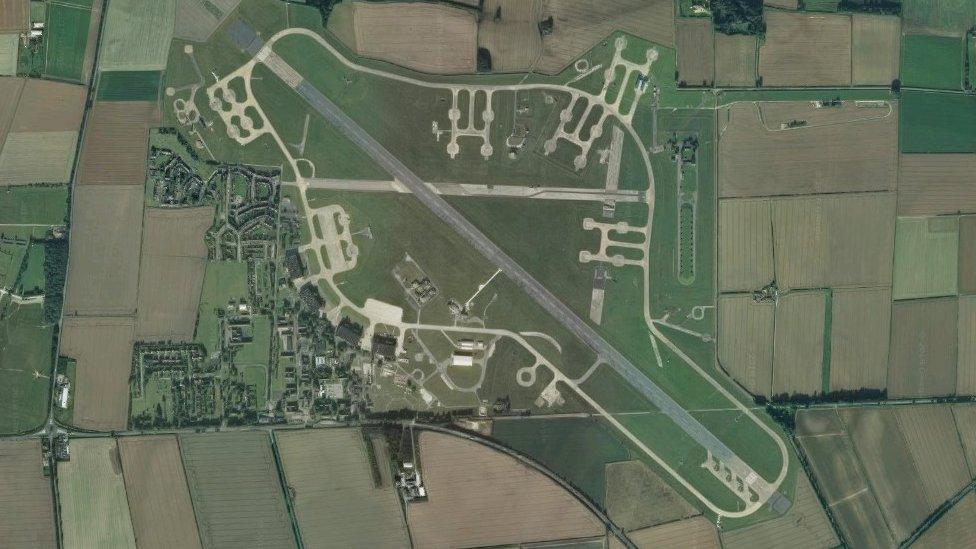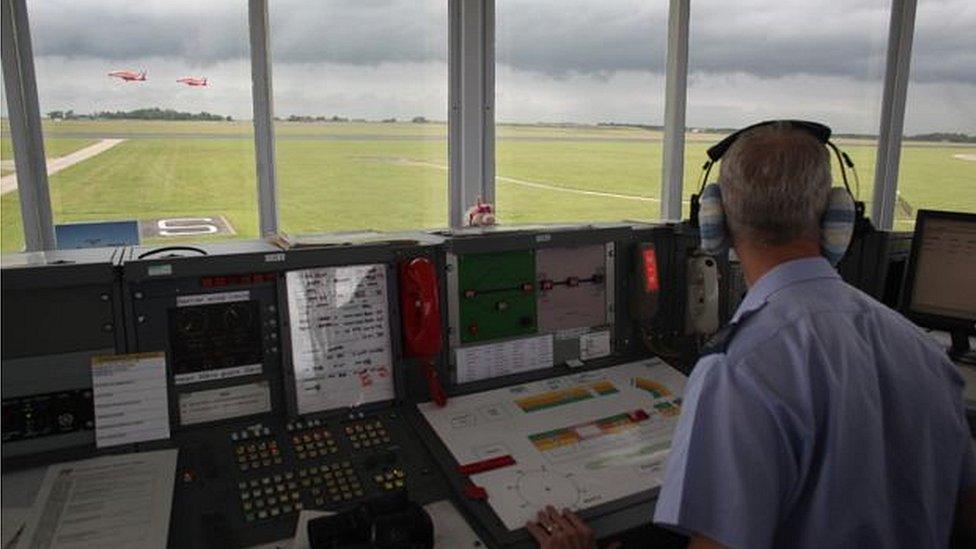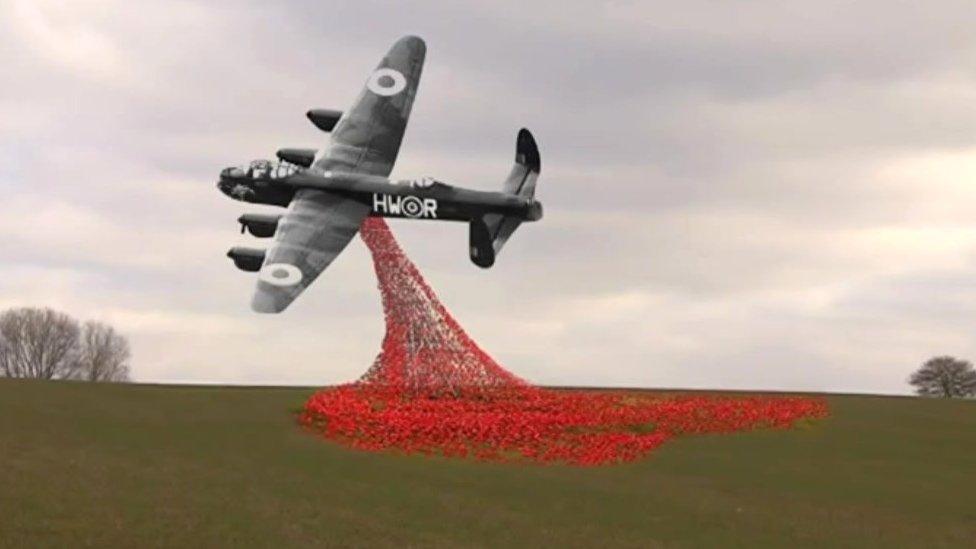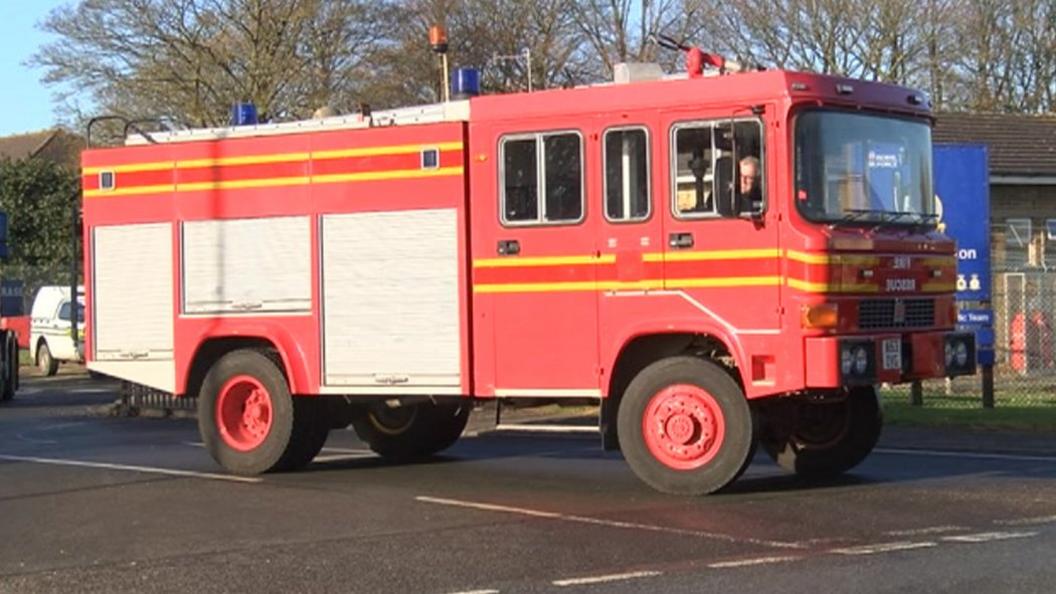Red Arrows RAF Scampton air base to be sold off
- Published
- comments
A Red Arrows engineer recorded video on Sunday as the team returned to RAF Scampton
The home of the Red Arrows air display team is to be sold off, the Ministry of Defence (MoD) has confirmed.
RAF Scampton, which was also home to 617 Squadron as they prepared for the Dambusters mission in World War Two, has housed the Red Arrows since 2000.
Six hundred people currently work at the site near Lincoln.
The MoD, which wants to save £3bn by 2040, is also closing RAF Linton-on-Ouse in North Yorkshire where 300 people work.
The government said RAF Scampton will close in 2022 with the Red Arrows relocating to a site "more fit for purpose".
Plans were also confirmed to transfer basic and fast jet training from RAF Linton-on-Ouse in North Yorkshire to RAF Valley on Anglesey in 2019 and cease using Linton in 2020.
Lincolnshire breaking news: Latest RAF Scampton closure updates

RAF Scampton is also where the Dambusters raids were launched
Air Chief Marshal Sir Michael Graydon, Chief of the Air Staff from 1992 to 1997, said: "Scampton is a very good base. It has an extremely long runway and is situated in a part of the country which is ideal in many ways.
"I just hope that all of these consequences of closing Scampton are fully understood and appreciated. I'd like to know where they are going to put the Red Arrows.
"The Red Arrows have been at Scampton for some time. I remember so well in the past we moved the Red Arrows around from pillar to post and it was not a good time."

Analysis
Jonathan Beale - Defence Correspondent

RAF Scampton has escaped previous cuts at the MoD
The decision behind the closure of RAF Scampton is mostly about saving money. A cash strapped MoD is aiming to sell off about one-third of its estate to make nearly £3bn of savings by 2040.
The Lincolnshire air base has just about managed to escape previous rounds of cuts, in part because of its history as home to the Dambusters and, more recently, the Red Arrows.
This will not be a popular decision, but defence sources say the base is looking tired and in need of investment. The RAF has assessed money would be better placed on improving its existing core sites.
Talks are already under way to find the Red Arrows a new home, including discussions with the Civil Aviation Authority to ensure the world renowned display team have the airspace they need to practise their aerobatic displays.
It's still not clear who'll be buying RAF Scampton, but the MoD says it will look at ways of keeping its history alive. That might include a small museum at the site.

In May 1943, Lancaster bombers of 617 Squadron left RAF Scampton to carry out air raids on the dams of the Ruhr valley.
The 102-year-old base has been at the heart of RAF operations ever since, but after surviving countless rounds of defence cuts it is now being sold.
By 2022 the Red Arrows will move to another base.
Sir Edward Leigh, Conservative MP for Gainsborough, Lincolnshire, said he was "saddened" that the base, which is in his constituency, was to be sold "as part of cost-saving measures".
He tweeted: "Not the best way to mark the #RAF100: closing the home of the RAF Red Arrows and Dambuster squadron."
Lincolnshire's Police and Crime Commissioner Marc Jones said losing the base "was as serious a blow as Lincoln losing the cathedral" would be.

RAF Scampton

The base has been the home of the Red Arrows since 2000
13 October 1916: Air Station Brattleby Cliff opened as a Home Defence Flight unit
1918: Renamed RAF Scampton in 1918
1943: 617 Squadron was established for the Dambusters mission
1956: The runway was extended to 10,000 feet for the Vulcan bombers
1983: Chosen as the base for the Red Arrows, which remains there until 1995
2000: Red Arrows return to RAF Scampton after five years at RAF Cranwell
2006: No 1 Air Control Centre deployed to Afghanistan
2016: RAF Scampton celebrated its centenary
2018: Ministry of Defence announces the base will be sold

Leader of West Lindsey District Council Jeff Summers said: "The RAF has a rich heritage in Lincolnshire and this news will be upsetting for many people.
"Together with Lincolnshire County Council we look forward to developing a plan for the site to explore the positives to ensure the heritage of RAF Scampton is reflected in future developments that meet the needs of the local economy."
- Published20 March 2018

- Published24 July 2018

- Published14 December 2017

- Published15 May 2018

- Published25 November 2017
